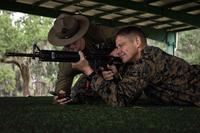 The Navy has begun to build a new fleet of air-cushioned Landing Craft Air Cushions -- ship-to-shore amphibious connector vehicles able to move sailors, Marines, equipment and gear across the ocean, service officials said.
The Navy has begun to build a new fleet of air-cushioned Landing Craft Air Cushions -- ship-to-shore amphibious connector vehicles able to move sailors, Marines, equipment and gear across the ocean, service officials said.
The Navy’s 72 LCACs, in service for decades since the 80s, can transport up to 60-tons, reach speed of 36-knots and travel ranges up to 200 nautical miles from amphibious vehicles, Navy officials explained.
With some of the existing fleet of LCACs approaching 30-years of service, the Navy needs to begin replacing them with new ones, service officials said.
The new LCACs, slated to first deliver in May of 2017, will include upgraded engines, software and digital controls. The Navy plans to deliver these first few new craft as a step toward building an entire fleet of 73 new connectors.
The first several new LCACs, called Ship-to-Shore Connectors or SSCs, will add new features such as increased payload, better engines and improved digital controls, he said.
The Navy contracted with Textron Systems to build an in-house Navy design for the SSCs through an initial construction deal to deliver up to eight new craft by 2020. The contract has a potential value of $570 million.
“This was the first Navy in-house design in over 10-years. We went to an advanced skirt which we prototyped in Panama City, Florida, which has less drag and is more fuel efficient,” said Capt. Chris Mercer, program manager for amphibious warfare.
The new SSCs also increase the strength of the deck and improve the propellers when compared with existing LCACs, he said. The new SSCs can carry up to 74-tons across the ocean, enough to move an M1A1 Abrams tank with a mine plow, Mercer said.
The approximate price of the first LCAC is $60 million, however, the Navy plans to drop the cost down to about $45 million each once more LCACs are produced.
Designed with over-the-horizon high-speed and maneuverability, LCACs are able to travel long distances and land on rocky terrain – even driving right up onto the shore.
“The LCACs can access over 70-percent of the shoreline across the world. We started experimenting with air-cushioned vehicles in the 60s, developed prototypes in the 70s, and got LCACs going in the early 80s. We delivered 91 of them and 72 are in service today,” Mercer added.
In order to bridge the gap from existing LCACs to the new SSCs, the Navy implemented a special service life extension program for the LCACs – many of which are now approaching three decades of service.
“We re-engined the craft with new engines, added new rotating machinery, new command and control systems, new skirts and fixes to corrosion issues. This put another 10 years of life back into the LCAC,” Mercer said.
Landing Craft Utility Vehicles
The Navy is also finalizing the design for a new Landing Craft Utility vehicle, or LCU. The initial results of a Navy analysis determined that the new LCU will be a modified version of the existing one, which has been in service since 1959. Like the LCAC, the new LCU is being determined by an in-house Navy design because of the services’ extensive experience with building connector craft.
“It is essentially a new LCU with a little more capability,” Mercer explained.
The Navy and Marine Corps currently operate 32 Landing Craft Utility vessels, which are large over-sea troop and equipment amphibious transporters able to transit as much as 125 tons worth of gear from ship to shore.
The current fleet of LCUs, which have an average age of about 43-years, can travel as far at 1,200 nautical miles over periods up to 10 days, Navy officials said.
The new program is called Surface Connector X Replacement, or SCXR.
Mercer explained that amphibious connector vehicles perform a range of vital functions from humanitarian disaster relief and non-combat evacuations to counterinsurgency and amphibious assault combat raids.
“If you do not have the connectors our con-ops don’t work,” Mercer said.
The new connectors will be designed to operate from a wide range of Navy amphibious ships, including the third America-class big deck amphib, LHA 8.
The yet-to-be built, still unnamed ship will be configured to carry two SSCs in its well deck, Mercer said. The third America-class big deck amphib brings the return of the well-deck to the ship class. The first to America-class amphibs - the USS America and USS Tripoli - were designed without a well-deck to maximize the use of aviation assets such as the F-35B and MV-22 Osprey.
The USS America was commissioned last October and the USS Tripoli is now 18-percent complete with its construction.
“We filled in the well-deck with aviation support spaces, enhanced the hangar, moved medical facilities and increased the square footage supporting aviation by 40-percent,” Mercer said.
The decision to make the first two America-class amphibs aviation-centric was based on the advantages of next-generation air-platforms and the need for vertical maneuvers at the height of two ongoing ground wars in Iraq and Afghanistan.
However, the rapidly increasing weight of ground vehicles coupled with the anticipated growing need for amphibious ship-to-shore operations inspired the return of the well-deck in LHA 8.
Mercer said that the initial design for LHA 8 is now complete, adding that bringing back a well-deck will be done in a way that does not compromise any aviation capability. This will be accomplished, in part, by building a smaller island to increase the flight deck space for aircraft.
One analyst said amphibious operations are likely to be in demand for decades to come given the current and future global environment.
“We would be operationally and strategically short-sighted not to retain unique amphibious capabilities within the Navy and Marine Corps team,” said Bryan McGrath, managing director of the FerryBridge Group, a Md.-based defense consultancy. “Amphibious operations give you the ability to be able to deliver Marines in a combat-ready state with a sense of mass. You can fly things over but you cannot replicate the mass that you can put on the beach. The Navy gives the Marine Corps the ability to move around and land in a number of potential places. You can’t defend everywhere. “







